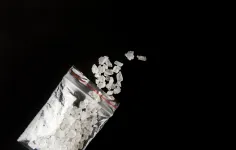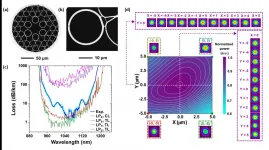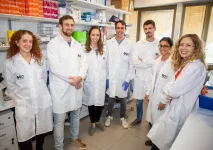A salt solution for desalinating brine
2021-02-22
(Press-News.org) Treating waste brine using a self-cleaning crystallizer that runs on solar power could be an eco-friendly and efficient way to make seawater desalination more sustainable.
In desert regions, seawater desalination provides essential freshwater for drinking and agriculture. A major problem is that the process generates vast quantities of concentrated brine that is often released into nearby lakes and rivers or back into the sea, harming vegetation and marine life. "With tightening environmental regulations and increasing public awareness, there is pressure to treat brine with zero liquid discharge," says Chenlin Zhang, a Ph.D. student in KAUST. This means extracting every last drop of water while leaving behind solid mineral crystals that can be salvaged for other uses.
Crystallization currently requires either expensive corrosion-resistant containers and large amounts of energy to boil the brine or large areas of land as dedicated evaporation ponds. Solar crystallizers that use photothermal materials to convert sunlight into heat are gaining popularity but have limited performance because they accumulate salt crystals, which reduce light absorption at the surface.
To tackle this, a team led by Peng Wang built a three-dimensional crystallizer that separates the photothermal material from the brine using highly conductive aluminum. Sunlight enters the open top of a square column and a photothermal coating on the inside wall transfers heat through an aluminum sheet to the outside walls. A porous membrane wrapped around the outside absorbs brine from a reservoir below and spreads it across the surface. The heat evaporates the water and salt crystals build up on the outside, leaving the inner wall clean.
"Accumulated salt can be easily scraped off by hand or left to build up enough to eventually fall under its own weight," explains Zhang. "Such self-cleaning could be very useful in industrial-scale systems."
Their device performed well on experimental salt solutions, but when tested on water from the Red Sea, evaporation rates slowed almost to zero and magnesium crystals clogged up the pores.
Wang's team resolved this by adding a small amount of nitrilotriacetic acid, a cheap and biodegradable crystallization inhibitor, to the untreated brine. "Our strategy could solve the long-standing issue of salt-scaling in conventional crystallizers and is a promising way to treat brine with zero liquid discharge," says Wang.
When powered by artificial sunlight, their crystallizer treated Red Sea brine continuously for 288 hours, evaporating water at an hourly rate of 2.42 kilograms per square meter of surface. When powered by real sunlight on the rooftop of a residential building at KAUST, it evaporated 48 kilograms of water per day per square meter of surface, despite the hours of darkness.
Wang's team is working on improvements to make their solar-powered crystallizer commercially scalable. "We will also investigate the recovery of useful minerals, such as magnesium and potassium, from the solid salts and reveal the true value of waste brine," he adds.
INFORMATION:
ELSE PRESS RELEASES FROM THIS DATE:
2021-02-22
Monoclonal antibodies are part of the therapeutic arsenal for eliminating cancer cells. Some make use of the immune system to act and belong to a class of treatment called "immunotherapies." But how do these antibodies function within the tumor? And how can we hope to improve their efficacy? Using innovative in vivo imaging approaches, scientists from the Institut Pasteur and Inserm visualized in real time how anti-CD20 antibodies, used to treat B-cell lymphoma, guide the immune system to attack tumor cells. Their findings were published in the journal Science Advances on February 19, 2021
Anti-CD20 antibodies are used in clinical practice to treat patients with B-cell lymphoma, a type of blood cancer. The treatment, often used in combination with chemotherapy, has been ...
2021-02-22
A mixture of smaller countries led by New Zealand, Vietnam, Taiwan, Thailand, Cyprus, Rwanda and Iceland led the world 's Top 10 countries to manage their COVID-19 response well, according to a new study.
In the study, published in The BMJ, lead researcher Flinders University's Professor Fran Baum joined experts from around the world to reflect upon the Global Health Security Index (October 2019) predictions for a public health emergency.
Along with Australia, Latvia and Sri Lanka among the best responders, the list highlights some of the 10 key causes of why some countries were successful or not in containing COVID-19 pandemic over the past year.
The US, UK, Netherlands, Australia, Canada, Thailand, Sweden, Denmark, South Korea, Finland (France, Slovenia and Switzerland) ...
2021-02-22
People with periodontitis are at higher risk of experiencing major cardiovascular events, according to new research from Forsyth Institute and Harvard University scientists and colleagues.
In a longitudinal study published recently in the Journal of Periodontology, Dr. Thomas
Van Dyke, Senior Member of Staff at Forsyth, Dr. Ahmed Tawakol of Massachusetts General Hospital, and their collaborators showed that inflammation associated with active gum disease was predictive of arterial inflammation, which can cause heart attacks, strokes, and other dangerous manifestations of cardiovascular disease.
For ...
2021-02-22
Despite deaths and hospitalisations linked to many new psychoactive substances (NPS), an international wastewater study led by the University of South Australia shows just how prevalent 'party pills' and 'bath salts' are in different parts of the world.
In a new paper published in Water Research, the world's most comprehensive wastewater analysis of NPS shows the pattern of designer drug use in the 2019/2020 New Year in 14 sites across Australia, New Zealand, China, The Netherlands, Spain, Italy, Norway and the United States.
UniSA analytical chemist Dr Richard Bade says samples were collected over the New Year in each country and ...
2021-02-22
CORVALLIS, Ore. - Oregon State University and U.S. Department of Agriculture researchers have significantly expanded the understanding of the hop genome, a development with important implications for the brewing industry and scientists who study the potential medical benefits of hops.
"This research has the unique ability to impact several different fields," said David Hendrix, an associate professor in the Department of Biochemistry and Biophysics and the School of Electrical Engineering and Computer Science at Oregon State. "If you're talking to beer drinkers, they will be excited about the brewing side. If you are talking to the medical field, they are going to be excited about the pharmaceutical potential."
The findings are outlined in ...
2021-02-22
CORVALLIS, Ore. - Scientists at Oregon State University and the U.S. Forest Service have demonstrated that DNA extracted from water samples from rivers across Oregon and Northern California can be used to estimate genetic diversity of Pacific salmon and trout.
The findings, just published in the journal Molecular Ecology, have important implications for conservation and management of these species, which are threatened by human activities, including those exacerbating climate change.
"There has been a dearth of this kind of data across the Northwest," said Kevin Weitemier, a postdoctoral fellow at Oregon State and lead author of the paper. "This allows us to get a quick snapshot of multiple populations and species all at once."
In addition to demonstrating ...
2021-02-22
CORVALLIS, Ore. - Desert bighorn sheep in the Mojave National Preserve in California and surrounding areas appear to be more resilient than previously thought to a respiratory disease that killed dozens of them and sickened many more in 2013, a new study has found.
Clint Epps, a wildlife biologist at Oregon State University, and several co-authors, found that exposure to one of the bacteria associated with the disease is more widespread among bighorn sheep populations in the Mojave, and that its presence dates further back, than scientists thought. But they also found that the overall number of infected bighorn has declined since 2013 in the populations surveyed.
Epps and his colleagues, including Nicholas Shirkey, an environmental scientist with ...
2021-02-22
Recent spotlights on IC-HCPCFs are due to the recently demonstrated outstanding ultralow-loss performances and their application capabilities. Nevertheless, while their attenuation achieves impressive figures, the challenge of accomplishing a low loss, single-mode (SM), and polarization-maintaining HCPCF perseveres.
In a new paper published in Light: Science & Applications, a team of scientists, led by Professor Fetah Benabid from the University of Limoges, France, and in collaboration of the University of Modena, Italy and the company GLOphotonics, proposed and ...
2021-02-22
CORVALLIS, Ore. - Dogs synchronize their behavior with the children in their family, but not as much as they do with adults, a new study from Oregon State University researchers found.
The findings are important because there is a growing body of evidence that dogs can help children in many ways, including with social development, increasing physical activity, managing anxiety or as a source of attachment in the face of changing family structures, the researchers said. Yet, very little research has focused on how dogs perceive and socially engage with children.
"The great news is that ...
2021-02-22
In the course of a new and groundbreaking study, led by Dr, Natalia Freund and the doctoral candidate Avia Waston at the Sackler Medical Faculty, the research group succeeded in isolating monoclonal antibodies, which hindered the growth of tuberculosis germs in laboratory mice. The antibodies were isolated from a patient who had succumbed to active tuberculosis disease but had since recovered. This is, in fact, the first time in history that researchers have managed to develop a "biological antibiotic" and demonstrate that human monoclonal antibodies can act as a substitute for the traditional chemical antibiotics and protect mice from pathogenic bacterial challenge. The study was carried out in a collaboration with two additional laboratories from the US ...
LAST 30 PRESS RELEASES:
[Press-News.org] A salt solution for desalinating brine








